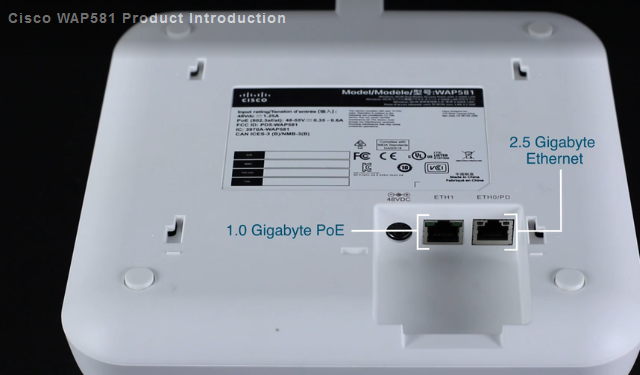
Cisco introduced a new member to the Small Business 500 Series, the WAP581. Designed for the Outdoor environment, what are the bright features of the new WAP581? Yes, the future of high-speed wireless is here. Get your network ready for the latest wireless technologies. The new Cisco WAP581 Access Point supports the 802.11ac Wave 2 Wi-Fi standard.
Gigabit Wi-Fi, Multigigabit Ethernet
Deliver gigabit wireless connectivity and guest access more securely and reliably. Improve your Wi-Fi coverage with a better mobile experience using the latest wireless technologies. The high-performance Cisco WAP581 Wireless-AC Dual Radio Wave 2 Access Point is designed to meet the needs of today’s wireless network and to deliver the best user experience.
Features and capabilities

- Supports 4×4 multiuser, multiple-input, multiple-output (MU-MIMO) technology on 5-GHz radio and 3×3 MIMO technology on 2.4-GHz radio for maximum performance.
- Supports dual Gigabit Ethernet (2.5 GE and 1 GE) LAN with Energy-Efficient Ethernet and link aggregation.
- Provides the Integrated Wireless Spectrum Analysis tool, which detects nearby radio frequency interference for easy troubleshooting.
- Offers a captive portal that facilitates highly secure guest access with customized roles and rights.
- Offers Single Point Setup, which requires no controller, for easy, cost-effective deployment of multiple access points.
- Works with the Cisco FindIT Network Management platform to manage and monitor your Cisco 100, 300, and 500 Series Access Points.
Specifications at a glance
- Concurrent dual-band radio: 2.8 Gbps on 5-GHz radio, 600 Mbps on 2.4-GHz radio
- Robust security: WPA2, 802.1X with RADIUS authentication, rogue access-point detection
- Wi-Fi Scheduler lets you control Wi-Fi access during and after business hours
- Integrated Wireless Packet Capture tool assists in troubleshooting
- Intelligent QoS prioritizes network traffic to keep critical applications at top performance
- Support for energy-saving sleep mode and port-control features
- Multiple internal antennas allow for installation on ceiling, wall or desktop
Compared to the WAP571 Indoor Access Point, what the new WAP581 AP can do for you?
Read the following comparison chart in details.
WAP581 |
WAP571 |
|
| General/Type | Indoor | Indoor |
Memory |
||
| Maximum installed RAM | 256 MB | 256 MB |
| Maximum installed flash memory | 128 MB | 128 MB |
Networking |
||
| Form factor | ABS plastic | ABS plastic |
| Connectivity technology | Wireless-AC, Wave 2 | Wireless-AC |
| Data transfer rate | Up to 2.8 Gbps | 1300+600 Mbps |
| Data link protocol | IEEE 802.11a/b/g/n/ac | IEEE 802.11a/b/g/n/ac |
| DFS support | Yes | Yes |
| Spread spectrum method | OFDM, DSSS | OFDM, DSSS |
| Remote management protocol | SNMPv3, HTTP, HTTPS | SNMPv3, HTTP, HTTPS |
| Network/transport protocol | DHCP, Bonjour | DHCP, Bonjour |
| Number of radios | 2 | 2 |
| Frequency band | 2.4 GHz and 5 GHz | 2.4 GHz and 5 GHz |
| MIMO | 4×4 MU-MIMO (5 GHz); 3×3 MIMO (2.4 GHz) | 3×3:3 for 2.4 GHz and 5 GHz |
| Maximum active WLAN clients | 64 per radio | 64 per radio |
| APs supported per cluster | 16 | 16 |
| Status indicators | One LED: Power, WLAN, LAN | One LED: Power, WLAN, LAN |
| Features | DHCP support, load balancing, VLAN support, syslog support, email alerts, IPv6 support, Wireless Distribution System (WDS) support, firmware upgradable, wall mountable, Spanning Tree Protocol (STP) support, Wi-Fi Multimedia (WMM) support, access control list (ACL) support, quality of service (QoS), RADIUS support, Wi-Fi Protected Setup (WPS), multiple SSID support, wireless bridge mode, IPv4 support, rogue access point detection, captive portal, RF spectrum analysis, Single Point Setup | DHCP support, load balancing, VLAN support, syslog support, email alerts, IPv6 support, Wireless Distribution System (WDS) support, firmware upgradable, wall mountable, Spanning Tree Protocol (STP) support, Wi-Fi Multimedia (WMM) support, access control list (ACL) support, quality of service (QoS), RADIUS support, Wi-Fi Protected Setup (WPS), multiple SSID support, wireless bridge mode, IPv4 support, rogue access point detection, captive portal, RF spectrum analysis, Single Point Setup |
| Roaming | 802.11r (when supported by driver) | 802.11r (when supported by driver) |
| Encryption algorithm | WPA, WPA2 | WPA, WPA2 |
| Authentication method | RADIUS, Radio Service Set ID (SSID) | RADIUS, Radio Service Set ID (SSID) |
| Compliant standards | IEEE 802.3, IEEE 802.3u, IEEE 802.1Q, IEEE 802.11b, IEEE 802.3af, IEEE 802.11d, IEEE 802.11g, IEEE 802.1x, IEEE 802.11i, IEEE 802.11e, IEEE 802.11n, Wi-Fi Protected Setup | IEEE 802.3, IEEE 802.3u, IEEE 802.1Q, IEEE 802.11b, IEEE 802.3af, IEEE 802.11d, IEEE 802.11g, IEEE 802.1x, IEEE 802.11i, IEEE 802.11e, IEEE 802.11n, Wi-Fi Protected Setup |
Antenna |
||
| Type | Internal integrated | Internal integrated |
| Antennas | 4 | 4 |
| Directivity | Dipole antennas | Dipole antennas |
| Gain level | 3.61 dBi on 2.4 GHz; 6.23 dBi on 5 GHz | 1.99 dBi maximum on 2.4 GHz; 1.28 dBi max on 5 GHz |
| Expansion/Connectivity | ||
| Interfaces | 2 x network/power: 1 x Ethernet 10BASE-T/1000BASE-TX RJ-45; 1 x Ethernet 2.5G (multigigabit) | 2 x network/power: Ethernet 10BASE-T/100BASE-TX RJ-45 |
Miscellaneous |
||
| Cables included | 1 x network cable | 1 x network cable |
| Mounting kit | Included | Included |
| Compliant standards | Safety: ● UL 60950-1 ● CAN/CSA-C22.2 No. 60950-1 ● IEC 60950-1 ● EN 60950-1 Radio approvals: ● FCC Part 15.247, 15.407 ● RSS-210 (Canada) ● EN 300.328, EN 301.893 (Europe) ● AS/NZS 4268.2003 (Australia and New Zealand) EMI and susceptibility (Class B): ● FCC Part 15.107 and 15.109 ● ICES-003 (Canada) ● EN 301.489-1 and -17 (Europe) | Safety: ● UL 60950-1 ● CAN/CSA-C22.2 No. 60950-1 ● IEC 60950-1 ● EN 60950-1 Radio approvals: ● FCC Part 15.247, 15.407 ● RSS-210 (Canada) ● EN 300.328, EN 301.893 (Europe) ● AS/NZS 4268.2003 (Australia and New Zealand) EMI and susceptibility (Class B): ● FCC Part 15.107 and 15.109 ● ICES-003 (Canada) ● EN 301.489-1 and -17 (Europe) |
Power |
||
| Power over Ethernet (PoE) | 802.3af/at | 802.3af/at |
| Power | PoE and AC (48V) | PoE |
| Voltage required | 48V | – |
Software and support |
||
| Operating system | Linux | Linux |
| Mean time between failures (MTBF) | – | – |
Cisco SMB Wireless Access Point in Brief
The table shows a snapshot of the Cisco SMB wireless access point portfolio.
Model |
Typical Deployment |
Distinguishing Feature(s) |
Most Current WLAN Standard Supported |
| WAP121 | Small office and home office | • Compact design with fixable mounting options (wall or ceiling) | • 802.11n, single-band (2.4 GHz only) |
| WAP125 | Small office and home office | • Compact design with desktop form factor and integrated stand | • 802.11ac, dual-band (2.4 and 5 GHz), Wave 1 |
| WAP131 | Small office needing business-class features | • Desktop form factor with integrated stand | • 802.11n, dual radio (2.4 GHz and 5 GHz, concurrent band) |
| WAP150 | Small office needing business-class features | • AC or Power over Ethernet (PoE) power
• Configure via mobile devices |
• 802.11ac, dual radio, Wave 1 |
| WAP361 | Hospitality, conference rooms, classrooms | • Integrated 5-port Gigabit Ethernet switch with Powered Device (PD) and Power Sourcing Equipment (PSE) support
• Compact design fits directly to the wall electrical/data junction box |
• 802.11ac, dual radio (2.4 GHz and 5 GHz, concurrent band), Wave 1 |
| WAP371 | Small office needing high-performance Wi-Fi access | • Access point clustering
• Wi-Fi scheduler (lets you turn off Wi-Fi when your business is closed) |
• 802.11ac dual radio (2.4 GHz and 5 GHz), Wave 1 |
| WAP561 | Midsize location with more users | • SmartSignal Antenna technology to broaden wireless coverage | • 802.11n, dual radios (2.4 GHz and 5 GHz, concurrent band) |
| WAP571 | Midsize location with more users | • Dual Gigabit Ethernet with Link Aggregation (LAG) support
• Built-in RF spectrum analysis |
• 802.11ac, dual radios (2.4 GHz and 5 GHz, concurrent band), Wave 1 |
| WAP571E | Outdoor deployment needing secure Wi-Fi access | • IP66-rated, surface or pole mounting
• Workgroup bridge for wirelessly connecting wired LANs |
• 802.11ac, dual radios (2.4 GHz and 5 GHz, concurrent band), Wave 1 |
WAP581 |
Midsize location with more users | • Dual Gigabit Ethernet (1 Gigabit Ethernet and 1 Multigigabit (2.5 Gigabit Ethernet)
• Built-in RF spectrum analysis |
• 802.11ac, dual radios (2.4 GHz and 5 GHz, concurrent band), Wave 2 |





